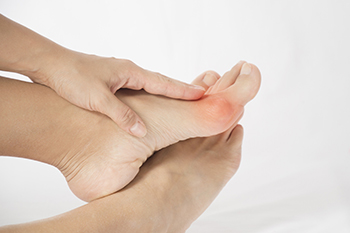What Can Be Done About Bunions
Tuesday, 23 May 2023 00:00
A bunion is medically referred to as a hallux valgus. It is a deformity of the metatarsophalangeal joint at the base of the big toe. This type of malformation can develop when the first metatarsal bone in the foot turns out, and the big toe shifts toward the other toes. Eventually, the fluid-filled sac that surrounds and cushions the joint may become inflamed, and the entire joint can become stiff and painful. A bunion can interfere with walking or exercising. Additionally, it can be difficult to find shoes that accommodate this protrusion, and if shoes do not fit properly, extra pressure may be put on this misaligned joint. Bunions are more common in women. Perhaps this is because women are more apt to wear narrow, pointed, or high-heeled shoes. Bunions can also be genetic, or may develop from an underlying illness, such as arthritis, or an abnormal foot structure. Some foot problems, such as high arches or flat feet, can predispose one to getting a bunion. A podiatrist can determine the severity of a bunion and recommend the appropriate treatment for it. If you have a bunion, it is suggested that you make an appointment with this type of doctor for an examination and relief options.
If you are suffering from bunion pain, contact Dr. Thomas Madden of Advanced Foot Care Center. Our doctor can provide the care you need to keep you pain-free and on your feet.
What Is a Bunion?
Bunions are painful bony bumps that usually develop on the inside of the foot at the joint of the big toe. As the deformity increases over time, it may become painful to walk and wear shoes. Women are more likely to exacerbate existing bunions since they often wear tight, narrow shoes that shift their toes together. Bunion pain can be relieved by wearing wider shoes with enough room for the toes.
Causes
- Genetics – some people inherit feet that are more prone to bunion development
- Inflammatory Conditions - rheumatoid arthritis and polio may cause bunion development
Symptoms
- Redness and inflammation
- Pain and tenderness
- Callus or corns on the bump
- Restricted motion in the big toe
In order to diagnose your bunion, your podiatrist may ask about your medical history, symptoms, and general health. Your doctor might also order an x-ray to take a closer look at your feet. Nonsurgical treatment options include orthotics, padding, icing, changes in footwear, and medication. If nonsurgical treatments don’t alleviate your bunion pain, surgery may be necessary.
If you have any questions, please feel free to contact our office located in Killeen, TX . We offer the newest diagnostic and treatment technologies for all your foot care needs.




